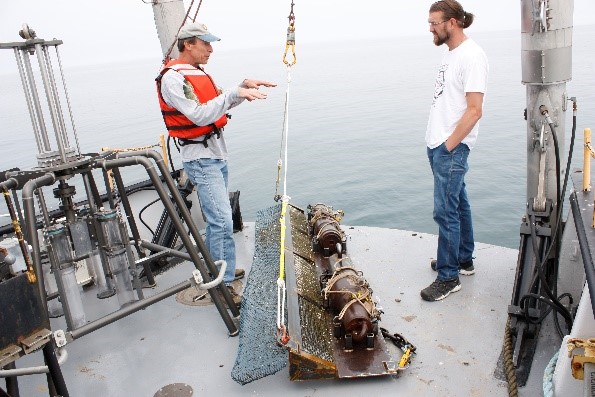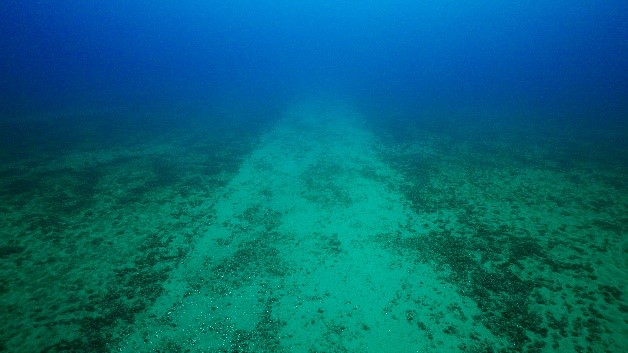Fall 2023 eNewsletter
Can Invasive Mussels Be Controlled?

Harvey Bootsma, PhD, (L) and Captain Max Morgan (R) discussing deployment of the “mussel masher”. Photo Credit: Charles Carignan.
Invasive quagga mussels have dramatically altered the structure and function of the Lake Michigan ecosystem. To date, research on these mussels has focused on understanding how they affect lake nutrient and food web dynamics, with the goal of guiding lake management strategies rather than remediation. There have been virtually no attempts to remove this invasive species in the Great Lakes. While remediation is logistically impossible at the ecosystem scale, Harvey Bootsma, PhD, of the University of Wisconsin-Milwaukee, a CIGLR Regional Consortium institution, along with doctoral student Karen Baumann (University of Wisconsin-Milwaukee) and collaborators Ashley Elgin, PhD, and Steve Ruberg from NOAA GLERL are exploring the potential of mussel removal as a method to restore critical habitats.
“Our group started experimenting with mussel removal methods in 2016,” said Bootsma. “Working with colleagues from the National Park Service and the Michigan Department of Natural Resources, we’ve had some success removing mussels at small scales in the lake’s nearshore zone.” The team cleared a 40 square meter experimental plot containing close to one million mussels at Good Harbor Reef on the coast of Michigan’s Sleeping Bear Dunes National Lakeshore, where the rocky bottom has remained virtually mussel-free for the last 7 years. “We’re still trying to understand why the mussels have not returned to that area,” said Bootsma.
“That research has really helped us to understand how these mussels affect nearshore food web structure and the growth of nuisance algae. However, at the whole ecosystem scale the effects of invasive mussels are primarily due to the trillions of quagga mussels living on deeper, soft substrate, where biological, chemical, and physical conditions are very different from those on nearshore rocky habitat. We expect that a mussel removal project on deeper substrate will lead to new insights about the role of mussels in the lake’s food web and nutrient cycles. It would also allow us to address questions that are difficult or impossible to address using more conventional experimental approaches, such as lab experiments or the interpretation of long-term data sets.”

The “mussel masher” on deck. Photo Credit: Harvey Bootsma.
Removing mussels from a deep-water area in Lake Michigan was very different from the methods used in the nearshore zone. Scuba divers removed mussels manually in shallow areas of Lake Michigan, but that is not practical or safe in deep-water areas. After testing several options, Bootsma built a device designed to crush mussels while being dragged behind a ship. Dubbed the “mussel masher,” the device, which weighs more than a half ton, was first tested in May 2023. After some small modifications, it was used in June at 40 meters depth to treat a 50 x 50 meter area of lake bottom. “Now, we’re monitoring that area to see how effective the masher was, and how the sediment chemistry and the biotic community are responding,” said Bootsma. “Initial sampling suggests that the treatment resulted in an 80% decline in mussel density, but we’re doing more sampling to get some statistical confidence in the numbers.”

A swath of Lake Michigan bottom after deployment of the “mussel masher”. Photo Credit: Zach Melnick, Inspired Planet Productions.
Bootsma and Baumann are now collecting sediment from the study area to determine the role of sediments and quagga mussels in the lake’s phosphorus cycle. “Understanding sediment phosphorus dynamics is critical,” explained Bootsma, “because it has implications for plankton production and the entire food web.” They are also monitoring other bottom-dwelling biota, including invertebrates and fish, to see how they respond to the removal of quagga mussels. “One of our goals is to see if we can remove quagga mussels at large enough scales to have a local positive impact,” said Bootsma. “But even if we can’t, we hope to better understand how biological, physical, and chemical processes on the lake bottom affect Lake Michigan as a whole, and how these processes are altered by the presence of quagga mussels in the lake. That understanding will allow us to better predict the lake’s response to factors such as nutrient inputs and climate change, and will help guide decisions related to management of the lake’s fish populations.”
Bootsma’s work has caught the attention of a film company, Inspired Planet Productions. His pioneer research into lake mussel removal is expected to be showcased in the documentary “All Too Clear” which highlights how invasive species have changed Great Lakes ecology. “Our research team is excited to be a part of this documentary and we look forward to future collaborations that inform the public about the role science plays in understanding and caring for these precious lakes,” said Bootsma.
